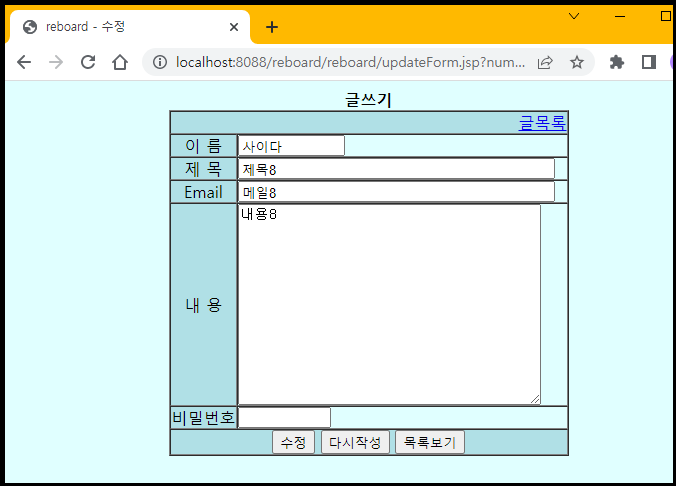답글 기능을 포함한 게시판 (4) - 수정, 삭제
- DBCP 방식 사용,
- 액션태그 사용 (useBean, setProperty)
- DTO, DAO 클래스
- 페이징 처리 (inline view)
- 답글 처리
프로그램 구조
| Java Resources > src > board |
DTO 클래스 | BoardDataBean.java | |
| DAO 클래스 | BoardDBBean.java | ||
| WebContent > reboard | reboard | writeForm.jsp | |
| writePro.jsp | |||
| list.jsp | |||
| content.jsp | |||
| replyForm.jsp | |||
| replyPro.jsp | |||
| updateForm.jsp | |||
| updatePro.jsp | |||
| deleteFrom.jsp | |||
| deletePro.jsp | |||
| META-INF | context.xml | 커넥션 풀 환경설정 파일 | |
| WEB-INF > lib | ojdbc6.jar | ||
| web.xml | 프로젝트 환경설정 파일 |
1. content.jsp의 [수정] 버튼을 클릭 이벤트로 updateForm.jsp와 연결한다.

get 방식으로 num값과 현재페이지 값을 저장한 nowpage값을 함께 넘긴다.

<input type="button" value="수정"
onClick="location.href='updateForm.jsp?num=<%= num %>&page=<%=nowpage%>' ">
2. updateForm.jsp 생성
writeForm.jsp 파일의 내용을 복사-붙여넣기 하여 수정 폼에 맞게 고친다.
get 방식으로 num값과 page값을 잘 가지고 넘어온 모습이다.

3. request 객체로 num값과 nowpage 값을 넘겨받는다.
문서 최상단의 페이지 태그 하단에 리퀘스트 객체를 적는다.
<%
int num = Integer.parseInt(request.getParameter("num"));
String nowpage = request.getParameter("nowpage");
%>
4. DB 연동 - DAO 객체 생성
<%
BoardDBBean dao = BoardDBBean.getInstance();
%>
5. num값을 매개로 getContent 메소드를 불러오는 코드를 작성
DAO 문서에 getContent 메소드를 생성한다.
이 getContent 메소드는 일전에 작성했던 updateContent를 그대로 복사-붙여넣기 하여 상세 내용을 수정한다.
<%
BoardDataBean board = dao.getContent(num);
%>
upcateContent와 달라지는 점
-> 글 조회 시 조회수를가 1 올라가도록 되어 있는데 해당 내용을 삭제한다.
public BoardDataBean getContent(int num) {
BoardDataBean board = new BoardDataBean();
Connection con = null;
PreparedStatement pstmt = null;
ResultSet rs = null;
try {
con = getConnection();
String sql = "select * from board where num=?";
pstmt = con.prepareStatement(sql);
pstmt.setInt(1, num);
rs = pstmt.executeQuery();
if(rs.next()) {
board.setNum(rs.getInt("num"));
board.setWriter(rs.getString("writer"));
board.setEmail(rs.getString("email"));
board.setSubject(rs.getString("subject"));
board.setPasswd(rs.getNString("passwd"));
board.setReg_date(rs.getTimestamp("reg_date"));
board.setReadcount(rs.getInt("readcount"));
board.setRef(rs.getInt("ref"));
board.setRe_level(rs.getInt("re_level"));
board.setRe_step(rs.getInt("re_step"));
board.setContent(rs.getString("content"));
board.setIp(rs.getString("ip"));
}
} catch (Exception e) {
e.printStackTrace();
} finally {
if (rs != null) try { rs.close();} catch (Exception e) {}
if (pstmt != null) try { pstmt.close();} catch (Exception e) {}
if (con != null) try { con.close();} catch (Exception e) {}
}
return board;
}
6.
이 부분은 통째로 지웠다.

7.
폼 태그의 액션 값을 writePro.jsp에서 updatePro.jsp로 수정했고,
hidden 객체의 값들을 수정했다.

8.
updateForm.jsp 진입 시 글 내용의 값들을 그대로 가져와 출력되도록
각 항목마다 value 값을 추가한다.
그리고 하단의 [글쓰기] 버튼의 value 값도 [수정]으로 고친다.
[목록보기]를 눌렀을 때 nowpage 값을 받아서 가도록 수정한다.



9.
비밀번호가 맞을 경우에만 수정이 가능하도록 설정하기 위해
updatePro.jsp 를 생성한다.
가장 먼저 한글 인코딩 설정 후, usebean 액션태그와 property를 불러오는 액션태그를 작성한다.
DTO 클래스에 없는 ip와 page 값을 따로 가져오는 리퀘스트 객체도 작성한다.
DB를 연동할 수 있는 DAO 객체를 생성한 후, old 라는 이름으로 값을 받도록 설정한다.
<%
request.setCharacterEncoding("UTF-8");
%>
<jsp:useBean id="board" class="reboard.BoardDataBean"></jsp:useBean>
<jsp:setProperty property="*" name="board"/>
<%
board.setIp(request.getRemoteAddr());
String nowpage = request.getParameter("page");
BoardDBBean dao = BoardDBBean.getInstance();
BoardDataBean old = dao.getContent(board.getNum());
%>
10. 비밀번호를 비교하는 조건문 작성
if(old.getPasswd().equals(board.getPasswd())) { // 비번 일치 시
int result = dao.update(board); // updateSQL 문 실행
if(result == 1) { %>
<script>
alert("글 수정 완료");
location.href="list.jsp?page=<%=nowpage%>";
</script>
<%}
} else { // 비번 불일치 시 %>
<script>
alert("비밀번호가 일치하지 않습니다.");
history.go(-1);
</script>
<% } %>
11. update 메소드 생성
public int update (BoardDataBean board) {
int result = 0;
Connection con = null;
PreparedStatement pstmt = null;
try {
con = getConnection();
String sql = "update board set writer=?, email=?, subject=?, content=? ";
sql += " where num=?";
pstmt = con.prepareStatement(sql);
pstmt.setString(1, board.getWriter());
pstmt.setString(2, board.getEmail());
pstmt.setString(3, board.getSubject());
pstmt.setString(4, board.getContent());
pstmt.setInt(5, board.getNum());
result = pstmt.executeUpdate();
} catch (Exception e) {
e.printStackTrace();
} finally {
if (pstmt != null) try { pstmt.close();} catch (Exception e) {}
if (con != null) try { con.close();} catch (Exception e) {}
}
return result;
}
12. deleteForm.jsp 생성
content.jsp에서 삭제 버튼에 클릭 이벤트로 deleteForm.jsp와 연결한다.
<input type="button" value="삭제"
onClick="location.href='deleteForm.jsp?num=<%= num %>&page=<%=nowpage%>' ">
updateForm.jsp의 내용을 복사-붙여넣기 하여 일부를 수정한다.
action값을 deletePro.jsp로 수정,
사용하지 않는 이름, 이메일, 글제목, 글내용 항목은 모두 지운다.
버튼은 [삭제]로 이름을 바꾸고 [목록보기]는 남겨둔다. [다시작성]은 지운다.
13. deletePro.jsp 생성
updatePro.jsp의 내용을 복사-붙여넣기 하여 수정한다.
달라지는 것은 비밀번호 일치 시 실행하는 메소드가 dao.delete(board) 인 것 뿐이다.

14. delete 메소드 생성
원글을 삭제할 때는
list.jsp 관리자에 의해 삭제되었다는 메시지를 출력하도록 한다.
public int delete(BoardDataBean board) {
int result = 0;
Connection con = null;
PreparedStatement pstmt = null;
String sql = "";
try {
con = getConnection();
if(board.getRe_level() == 0) { // 1. 원문 삭제일 경우
sql = "update board set subject=?, content=? where num=?";
pstmt = con.prepareStatement(sql);
pstmt.setString(1, "관리자에 의해 삭제된 게시물입니다");
pstmt.setString(2, " ");
pstmt.setInt(3, board.getNum());
} else { // 2. 답글 삭제일 경우
sql = "delete from board where num=?";
pstmt = con.prepareStatement(sql);
pstmt.setInt(1, board.getNum());
}
result = pstmt.executeUpdate();
} catch (Exception e) {
e.printStackTrace();
} finally {
if (pstmt != null) try { pstmt.close();} catch (Exception e) {}
if (con != null) try { con.close();} catch (Exception e) {}
}
return result;
}